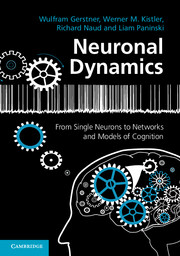Book contents
- Frontmatter
- Contents
- Preface
- PART ONE FOUNDATIONS OF NEURONAL DYNAMICS
- PART TWO GENERALIZED INTEGRATE-AND-FIRE NEURONS
- PART THREE NETWORKS OF NEURONS AND POPULATION ACTIVITY
- 12 Neuronal populations
- 13 Continuity equation and the Fokker–Planck approach
- 14 Quasi-renewal theory and the integral-equation approach
- 15 Fast transients and rate models
- PART FOUR DYNAMICS OF COGNITION
- References
- Index
14 - Quasi-renewal theory and the integral-equation approach
Published online by Cambridge University Press: 05 August 2014
- Frontmatter
- Contents
- Preface
- PART ONE FOUNDATIONS OF NEURONAL DYNAMICS
- PART TWO GENERALIZED INTEGRATE-AND-FIRE NEURONS
- PART THREE NETWORKS OF NEURONS AND POPULATION ACTIVITY
- 12 Neuronal populations
- 13 Continuity equation and the Fokker–Planck approach
- 14 Quasi-renewal theory and the integral-equation approach
- 15 Fast transients and rate models
- PART FOUR DYNAMICS OF COGNITION
- References
- Index
Summary
In the previous chapter it was shown that an approach based on membrane potential densities can be used to analyze the dynamics of networks of integrate-and-fire neurons. For neuron models that include biophysical phenomena such as refractoriness and adaptation on multiple time scales, however, the resulting system of partial differential equations is situated in more than two dimensions and therefore difficult to solve analytically; even the numerical integration of partial differential equations in high dimensions is slow. To cope with these difficulties, we now indicate an alternative approach to describing the population activity in networks of model neurons. The central concept is expressed as an integral equation of the population activity.
The advantage of the integral equation approach is four-fold. First, the approach works for a broad spectrum of neuron models, such as the Spike Response Model with escape noise and other Generalized Linear Models (see Chapter 9) for which parameters can be directly extracted from experiments (see Chapter 11). Second, it is easy to assign an intuitive interpretation to the quantities that show up in the integral equation. For example, the interspike interval distribution plays a central role. Third, an approximative mathematical treatment of adaptation is possible not only for the stationary population activity, but also for the case of arbitrary time-dependent solutions. Fourth, the integral equations provide a natural basis for the transition to classical “rate equations,” which will be discussed in Chapter 15.
- Type
- Chapter
- Information
- Neuronal DynamicsFrom Single Neurons to Networks and Models of Cognition, pp. 357 - 394Publisher: Cambridge University PressPrint publication year: 2014



